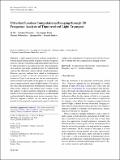| dc.contributor.author | Wu, Di | |
| dc.contributor.author | Wetzstein, Gordon | |
| dc.contributor.author | Barsi, Christopher | |
| dc.contributor.author | Willwacher, Thomas | |
| dc.contributor.author | Dai, Qionghai | |
| dc.contributor.author | Raskar, Ramesh | |
| dc.date.accessioned | 2017-03-10T23:20:15Z | |
| dc.date.available | 2017-03-10T23:20:15Z | |
| dc.date.issued | 2013-12 | |
| dc.date.submitted | 2013-02 | |
| dc.identifier.issn | 0920-5691 | |
| dc.identifier.issn | 1573-1405 | |
| dc.identifier.uri | http://hdl.handle.net/1721.1/107396 | |
| dc.description.abstract | Light transport has been analyzed extensively, in both the primal domain and the frequency domain. Frequency analyses often provide intuition regarding effects introduced by light propagation and interaction with optical elements; such analyses encourage optimal designs of computational cameras that efficiently capture tailored visual information. However, previous analyses have relied on instantaneous propagation of light, so that the measurement of the time dynamics of light–scene interaction, and any resulting information transfer, is precluded. In this paper, we relax the common assumption that the speed of light is infinite. We analyze free space light propagation in the frequency domain considering spatial, temporal, and angular light variation. Using this analysis, we derive analytic expressions for information transfer between these dimensions and show how this transfer can be exploited for designing a new lensless imaging system. With our frequency analysis, we also derive performance bounds for the proposed computational camera architecture and provide a mathematical framework that will also be useful for future ultra-fast computational imaging systems. | en_US |
| dc.description.sponsorship | MIT Media Lab Consortium | en_US |
| dc.description.sponsorship | Natural Sciences and Engineering Research Council of Canada | en_US |
| dc.publisher | Springer US | en_US |
| dc.relation.isversionof | http://dx.doi.org/10.1007/s11263-013-0686-0 | en_US |
| dc.rights | Creative Commons Attribution-Noncommercial-Share Alike | en_US |
| dc.rights.uri | http://creativecommons.org/licenses/by-nc-sa/4.0/ | en_US |
| dc.source | Springer US | en_US |
| dc.title | Ultra-fast Lensless Computational Imaging through 5D Frequency Analysis of Time-resolved Light Transport | en_US |
| dc.type | Article | en_US |
| dc.identifier.citation | Wu, Di, Gordon Wetzstein, Christopher Barsi, Thomas Willwacher, Qionghai Dai, and Ramesh Raskar. “Ultra-Fast Lensless Computational Imaging through 5D Frequency Analysis of Time-Resolved Light Transport.” International Journal of Computer Vision 110, no. 2 (December 28, 2013): 128–140. | en_US |
| dc.contributor.department | Massachusetts Institute of Technology. Media Laboratory | en_US |
| dc.contributor.department | Program in Media Arts and Sciences (Massachusetts Institute of Technology) | en_US |
| dc.contributor.mitauthor | Wu, Di | |
| dc.contributor.mitauthor | Wetzstein, Gordon | |
| dc.contributor.mitauthor | Barsi, Christopher | |
| dc.contributor.mitauthor | Raskar, Ramesh | |
| dc.relation.journal | International Journal of Computer Vision | en_US |
| dc.eprint.version | Author's final manuscript | en_US |
| dc.type.uri | http://purl.org/eprint/type/JournalArticle | en_US |
| eprint.status | http://purl.org/eprint/status/PeerReviewed | en_US |
| dc.date.updated | 2016-08-18T15:41:34Z | |
| dc.language.rfc3066 | en | |
| dc.rights.holder | Springer Science+Business Media New York | |
| dspace.orderedauthors | Wu, Di; Wetzstein, Gordon; Barsi, Christopher; Willwacher, Thomas; Dai, Qionghai; Raskar, Ramesh | en_US |
| dspace.embargo.terms | N | en |
| dc.identifier.orcid | https://orcid.org/0000-0002-3254-3224 | |
| mit.license | OPEN_ACCESS_POLICY | en_US |
